I've got a scroll view contained directly inside the content view of a view controller, at full size in both dimensions. The top, bottom, leading and trailing space constraints from the scroll view to its superview (horizontal) and the layout guides (vertical) are all set to 0. The VC is eventually meant to be nested as a child view controller in one or two places. I'm using a Storyboard.
I've placed a number of elements inside the scroll view and constrained them to it, but I'm seeing various kinds of strange behavior. Below is a screenshot with all the subviews of the scroll view selected to display their constraints. The scroll view's four constraints to the top level view are not visible in it. The view controller has been set to Freeform size, with its top level view (and, accordingly, the scroll view's content view) 616 pts high, guaranteeing that scrolling will be necessary at runtime.

Before analyzing the screenshot, here's a list of things that I'm trying to achieve.
- The vertical spacing between elements is set by the designer and fixed. (BTW, none of the vertical constraints, text styles etc. in this wireframe are final yet; the whole image is for illustrative purposes only.)
- All the labels (except the topmost one) should start at their intrinsic size, expand up to the width of the scroll view (minus the standard HIG horizontal space of 20 pts on both sides).
- Buttons are unlikely to be much bigger than this, but in case of localization surprises, we want them to behave just like the labels. (There's an extra vertical ≥ constraint on "Another Button"; it's irrelevant to this question.)
- The web view has a fixed height, and its width should be determined by the width of the scroll view; standard 20 pt horizontal space on both sides.
- The text views have a minimum height (67 pts here), but they should expand vertically if the contained text is too big to fit. None of them are editable or scrollable. Like the web view, they're horizontally spaced the standard 20 pts apart from the leading and trailing edges.
As you can see, none of the elements have explicit width constraints. The whole thing relies on the leading and trailing space constraints between the elements and the scroll view. The layout, in my mind, would somewhat gracefully work on hypothetical wider-than-320 pt iPhones of the future without changes to the constraints. It would also work after rotating to landscape orientation (it might look a bit silly, but it would work).
I'll go through the points step by step, referring to the screenshot where necessary.
1: This works, nothing out of the ordinary here.
2: The leading constraints of the labels are all simple Equal 20 pt standard spaces. The trailing constraints are Greater Than or Equal 20 pt standard, ostensibly to allow them to grow to be scrollView.frame.size.width-40 wide, but no wider.
3: Same as 2.
4 and 5: Here's where it gets interesting. The web view and the text views are all listed as Misplaced Views, with IB saying their frames will be different at runtime. The orange dashed borders denoting the correct frames only reach horizontally as far as the longest element with a Greater Than Or Equal trailing constraint; here, it's "A Button With A Long Title", whose right edge is where the dashed border edges end.
Constructing this set of views and their constraints, I expected to have some trouble. I knew it would be tricky to have UITextViews that grow vertically taller than the ≥ 67 height defined here, perhaps only possible through code. Getting the labels and buttons to work as specified above through IB alone seemed a bit iffy, too.
What I didn't expect was the web and text views' reported correct frame being only as wide as the widest label or button. It seems that with this setup, the scroll view won't actually be 320 pts wide, but rather only as wide as necessary to fit the longest element and its spacing, and the web and text views are expected to comply. Given that the scroll view is firmly constrained on all sides to the top level view, which is set to be 320 pts wide, I have no idea why this is. SOMETHING must obviously define the initial width of the scroll view, but why aren't the constraints I've made from the scroll view to the top level view doing that?
Given the specifications above for this set of views, what do I need to change to make it happen?
This case demonstrates the fact that I truly do not properly understand Auto Layout yet, and I hope that the answers will enlighten me about many of its crucial aspects.